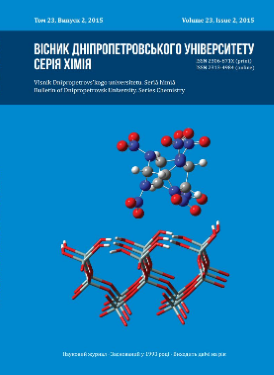Industrial lubricants based on renewable raw materials. Report 1. Properties of the natural acylglycerols
DOI:
https://doi.org/10.15421/081516Keywords:
lubricants, animal fat, recycling, rheometric characterizationAbstract
The paper analyzes and generalizes the information available on animal fats that can be used as secondary raw materials in production of lubricants compatible with the new recycling technologies. The paper reviews the current market of lubricants, analyses the environmental problems in manufacturing of petroleum-based lubricants and suggests a new class of alternative raw materials for the lubricant production. The experimental studies showed that sunflower oil contains the highest number of unsaturated bonds as compared to other fats. The iodine number measurements of the beef and chicken fats indicated that the latter contains more unsaturated carboxylic acids. Dynamic viscosity of the beef fat is much higher than that of other studied fats. The synthetic acylglycerols have higher temperature-dependent and shear viscosity as compared to the original fats. The paper presents the results of experimental physicochemical and rheometric studies of animal fats. It is shown that animal fat-based materials may serve as an alternative source of environmentally-friendly lubricants.References
Burlaka, V. G. (2003). Motor fuels and oils market in Ukraine. Oil and Gas, 7, 60–66.
Dudaryeva, Yu. O., & Dibrova, T. H. (2012). Features branding on the lubricants market. Actual Problems of Economics and Management, 29, 29–36.
Evdokimov, A. Yu., & Fuks, I. G. (2000). [Lubricants and environmental problems]. Moscow, Russian Federation: Oil and Gas (in Russian).
Mykhaylyuk O. (2012). Agroecological and economic consequences of rape cultivation and biodiesel production in southern Ukraine. Policy Brief, National Institute for Strategic Studies. Retrieved from http://od.niss.gov.ua/articles/482/
Bondar O. (2012). National Report on the State of Environment in Ukraine in 2011. Ministry of Ecology and Natural Resources of Ukraine.
Sirenko, H. A., Кuzyshyn, О. V., Midak, L. Ya., Kyrychenko, L. M., & Kyrychenko V. I. (2007). Wear Ability of Metal Surfaces in Lubrication with Polycomponent Compositions Based on Chemical-Modification Rape-Oil. Physics and chemistry of solid state, 3, 641–650.
Ostrikov, V. V., Nagornov, S. A., & Kleymenov O. A. (2008). [Fuel, lubricants and industrial fluids]. Tambov, Russian Federation: TSTU (in Russian).
Products company Total (2015). Retrieved from http://www.mssoil.ru/allabout/grease/1/
Pop, H. S. (2006). Lubricants from vegetable oils. Chemical Industry in Ukraine, 5, 22–29.
Sirenko, H. O., & Sav’yak, O. L. (2006). The study of plant oils as lubricants. Polymer journal, 1(28), 69–78.
Kyrychenko, L. M., Kyrychenko, V. I., & Sirenko, G. O. (1996). Tribological characteristics of new lubricating compositions based on chemically modified rapeseed oil. Problems of modern engineering.
Bioschmierstoffe – umweltfreundliche High-Tec-Schmierung (2013). Der Fachagentur Nachwachsende Rohstoffe. Retrieved from http://bioschmierstoffe.fnr.de/
Fuks, I. G., Evdokimov, A. Yu., Dzhamalov, A. A., & Luksa, A. (1992). Vegetable oils and animal fats – raw materials for the preparation of commodity lubricants. Chemistry and technology of fuels and oils, 4, 34–39.
Furumoto E., Ibuki M., Imamura Y., & Nishimoto T. (1999). Pat. EP 0744455 В1. Retrieved from Espacenet.
Zinovev, A. A. (1952). [Chemistry of fats]. Moscow, USSR: Pishchepromizdat (in Russian).
Downloads
Published
Issue
Section
License
Copyright (c) 2015 Oles Honchar Dnipropetrovsk National University

This work is licensed under a Creative Commons Attribution 4.0 International License.
- Authors reserve the right of attribution for the submitted manuscript, while transferring to the Journal the right to publish the article under the Creative Commons Attribution License. This license allows free distribution of the published work under the condition of proper attribution of the original authors and the initial publication source (i.e. the Journal)
- Authors have the right to enter into separate agreements for additional non-exclusive distribution of the work in the form it was published in the Journal (such as publishing the article on the institutional website or as a part of a monograph), provided the original publication in this Journal is properly referenced
- The Journal allows and encourages online publication of the manuscripts (such as on personal web pages), even when such a manuscript is still under editorial consideration, since it allows for a productive scientific discussion and better citation dynamics (see The Effect of Open Access).


